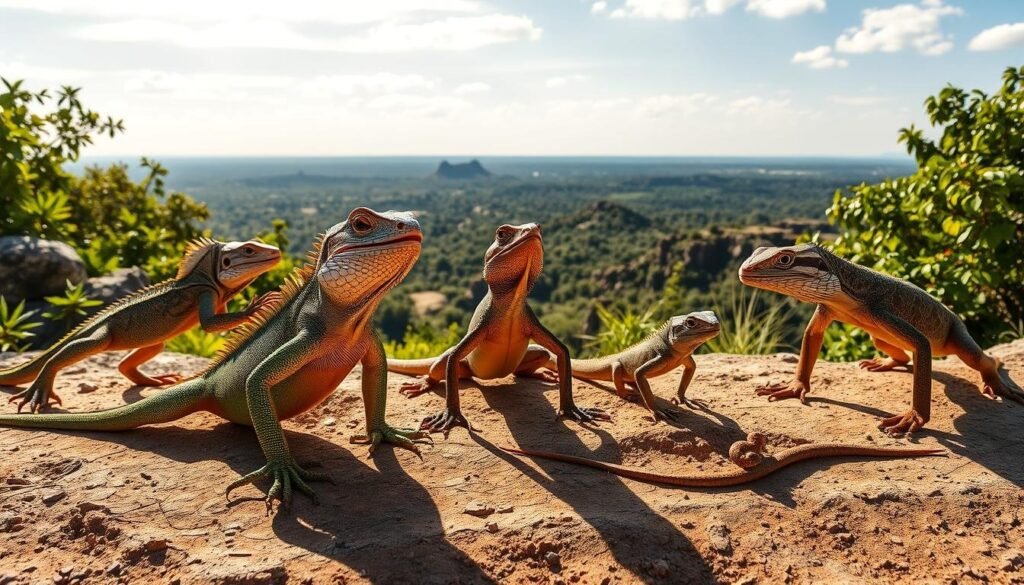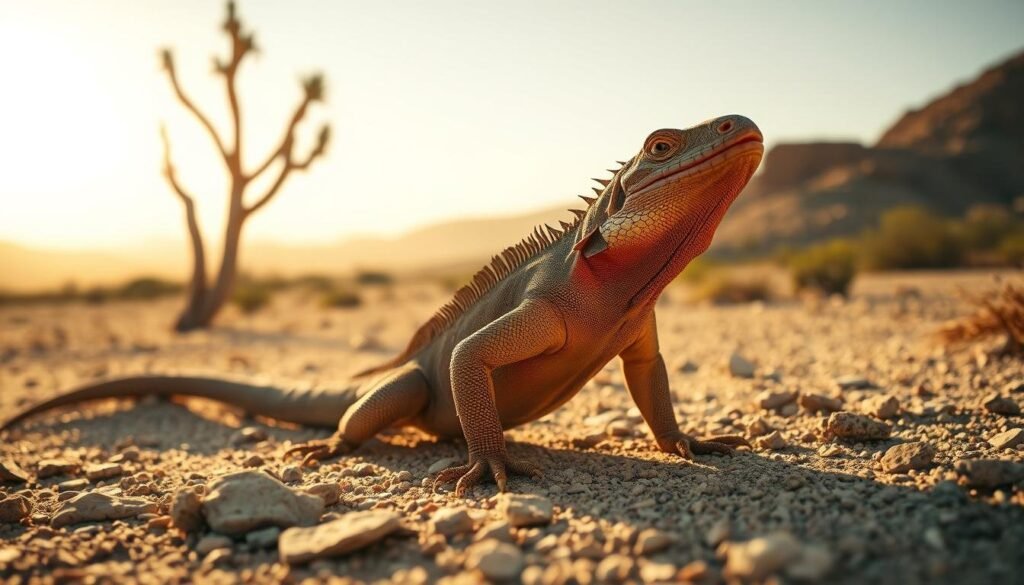Why Lizards Do Push-Ups During Mating Season? Have you ever seen a lizard doing push-ups near a sunny rock or sandy dune? It’s not just a simple exercise. It’s a key part of their mating season rituals.
Male lizards do push-ups to attract females and scare off rivals. This display shows off their strength and vigor. It proves they’re good mates. By studying lizard behavior, we learn about reptile courtship and the role of push-ups in their mating rituals.
As we dive into this topic, you’ll see the detailed reasons behind these behaviors. You’ll understand what they tell us about lizards’ social lives.
Contents
- 1 The Fascinating World of Lizard Body Language
- 2 Why Do Lizards Do Push-Ups During Mating Season?
- 3 Push-Up Variations Across Popular Lizard Species
- 4 The Evolutionary and Survival Benefits of Push-Up Displays
- 5 Understanding Lizard Mating Behaviors
- 6 FAQ: Why Lizards Do Push-Ups During Mating Season?
- 6.1 Why do lizards perform push-ups during mating season?
- 6.2 What is the significance of color changes during lizard displays?
- 6.3 How do different environments influence lizard mating behaviors?
- 6.4 Are there differences in push-up displays between wild and captive lizards?
- 6.5 What are the evolutionary benefits of push-up displays in lizards?
- 6.6 How do lizards use body positioning during courtship displays?
- 6.7 Do different lizard species exhibit unique push-up display variations?
The Fascinating World of Lizard Body Language
Lizard body language is full of secrets. They send messages through different signals, especially when they’re looking for a mate. These creatures show off complex behaviors shaped by their surroundings and who they meet.
Spring and Summer Behaviors
In spring and summer, lizards are more lively. They show off by doing push-ups and head-bobs. These actions help them show who’s boss and find a partner.
The time when lizards mate changes based on where they live. This is because of things like weather and where they live:
- In warmer places, lizards can mate all year.
- In cooler areas, they usually mate in spring and summer.
- In places with wet and dry seasons, rain can start their breeding.
Knowing these differences helps us see how flexible and varied lizard behaviors are. By looking at how they act, we can better understand their social lives and how they use body language to talk to each other.
Why Do Lizards Do Push-Ups During Mating Season?
Have you seen lizards doing push-ups during mating season? It’s part of a complex mating ritual. They use visual displays to attract mates and scare off rivals.
Lizards send many signals during mating season. Push-up displays are among the most striking. They also change color and position their bodies.
Color Changes During Displays
Many lizard species change color during mating displays. These changes can be very dramatic. For example, Anolis lizards show off bright dewlap displays, often with push-ups.
These color changes have several purposes. They show the lizard’s health, strength, and suitability as a mate. Bright colors attract females and scare off rivals.
Lizards also adjust their body position during displays. They stand tall, spread their limbs, or do push-ups to look bigger and stronger. This makes them appear more intimidating.
Body positioning also shows a lizard’s intentions. A ready-to-mate lizard may show a specific posture. This signals its readiness to potential partners.
In conclusion, push-up behavior in lizards during mating season is complex. It includes color changes and strategic body positioning. These visual cues are key for attracting mates and deterring rivals, playing a vital role in their mating rituals.
Push-Up Variations Across Popular Lizard Species
Exploring the world of lizards reveals fascinating push-up displays during mating season. Each species has its own unique push-up behaviors. Some do rapid push-ups, while others move slowly and deliberately.
Popular pet lizards like bearded dragons and anoles show these differences. Bearded dragons bob their heads as part of their courtship, which includes push-ups. Anoles, on the other hand, do quick push-ups and show off their colorful dewlaps.

The environment greatly influences lizard push-up behaviors. In the wild, they face dangers like predators and competition. This shapes their courtship displays. In captivity, lizards may act differently without these pressures.
Some main differences between wild and captive lizards include:
- Frequency of push-up displays: Captive lizards might push-up less often because they don’t compete.
- Intensity of displays: Wild lizards often show more intense push-ups due to environmental challenges.
- Context of displays: In captivity, lizards might push-up for their owners or decorations.
Knowing these differences helps us understand how mating behaviors vary among lizard species. It shows their adaptability and diversity.
The Evolutionary and Survival Benefits of Push-Up Displays
Lizards show off with push-up displays during mating season. These displays are not just for fun. They help lizards show their strength and claim territory to others.
Push-up displays change a lot between species and are affected by where they live. For example, desert lizards do different displays than forest lizards.
Desert vs. Forest Display Variations
Desert lizards can do more elaborate push-ups because they have open spaces. Forest lizards, on the other hand, have to keep their displays simple because of the dense trees.
| Ecosystem | Display Characteristics | Environmental Influence |
|---|---|---|
| Desert | More elaborate, higher visibility | Open spaces allow for greater visibility |
| Forest | More subdued, less frequent | Dense vegetation reduces visibility |
Learning about these differences helps us see how lizards adjust their mating rituals to their environment. This adjustment helps them survive and reproduce better.
Understanding Lizard Mating Behaviors
You now know more about lizard mating behaviors, especially the push-up displays. By looking into lizard behavior and animal courtship rituals, we see how important these are. They are key in the reptile mating habits of many species.
Lizard social and reproductive behaviors are both interesting and show the wide range of animal courtship in nature. Push-up displays are a way to communicate. They help show who’s in charge, attract mates, and mark territory.
Understanding lizard behavior helps us see the natural world in a new light. It shows us the complex relationships in ecosystems. This knowledge encourages us to learn more about reptiles and their unique ways of mating.
See Also: Why Do Peacocks Spread Their Colorful Feathers?
FAQ: Why Lizards Do Push-Ups During Mating Season?
Why do lizards perform push-ups during mating season?
Lizards do push-ups to attract mates and scare off rivals. It shows they are strong, healthy, and have a good territory.
What is the significance of color changes during lizard displays?
Color changes are key in lizard displays. They show aggression, courtship, or defense of territory. Each species and environment has its own way of using color.
How do different environments influence lizard mating behaviors?
Environments like deserts or forests shape lizard mating behaviors. They adapt their displays to fit their surroundings and ecological pressures.
Are there differences in push-up displays between wild and captive lizards?
Yes, wild and captive lizards show push-up displays differently. Captive environments can restrict natural behaviors, affecting display frequency and intensity.
What are the evolutionary benefits of push-up displays in lizards?
Push-up displays help lizards in many ways. They improve mating success, defend territory, and signal strength and health to others.
How do lizards use body positioning during courtship displays?
Lizards use body positioning to share information. They show their intentions, status, and quality through specific postures and orientations.
Do different lizard species exhibit unique push-up display variations?
Yes, each lizard species has its own push-up display. These variations reflect their adaptations to environments, ecological pressures, and social contexts.

Zyair Larson, based in Denver, Colorado, has over 12 years of experience studying animal behavior. He has worked with the World Wildlife Fund (WWF) and National Geographic, researching wildlife and sharing insights on animal habits globally.

